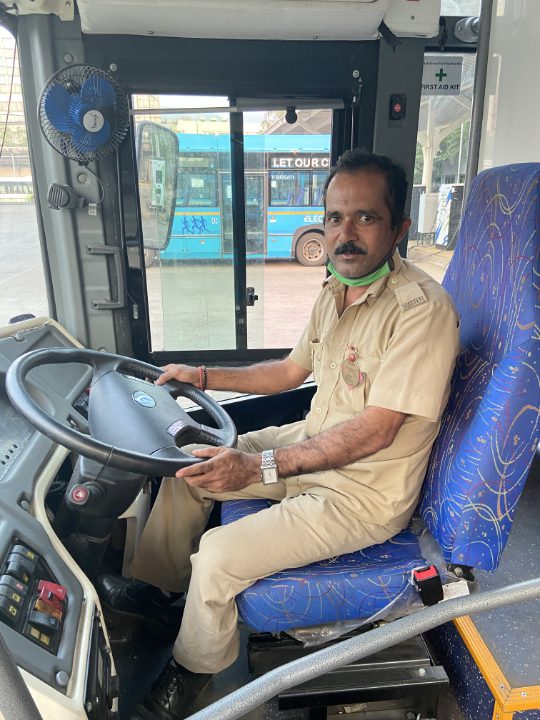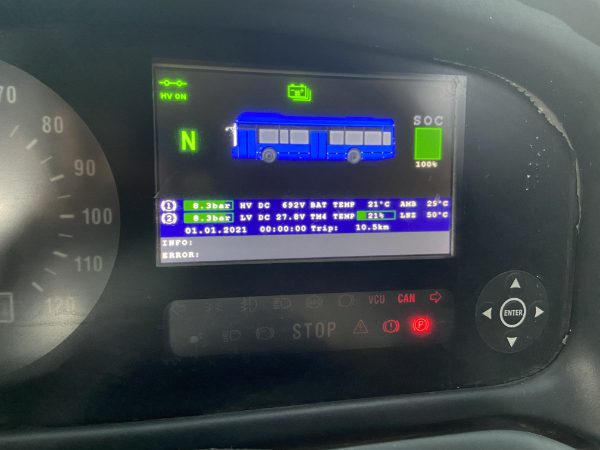Maharashtra’s transit authorities report positive experiences with electric buses
Blog
How electric buses are improving bus operations in India
The second in a three-part series about our conversations with authorities in Pune, Mumbai, and Navi Mumbai.
In the first blog post of this series, I explained how ICCT’s survey found that transit authorities in Maharashtra are satisfied with their battery-electric buses and have a positive outlook on the future of the technology. In this second blog post, I’d like to share a few details about how the electric buses are alleviating some of the difficulties that can be found with internal combustion engine (ICE) bus operations. This is based on more than 20 interviews with transit authorities in three cities in Maharashtra—Mumbai, Pune, and Navi Mumbai—and with their private bus operators.
Driving experience
The transit authorities reported that electric buses are more comfortable for drivers and have many safety-related features that are not present on the ICE buses in their fleets, including an automatic steering lock for a parked bus, alerts if the doors/boot/charging port lid are open, and steering angle adjustment for the driver.

Santosh Patil in an electric bus in Navi Mumbai. Photo by Anuj Dhole.
Santosh Patil, a driver from Navi Mumbai Municipal Transport (NMMT), also talked about the superior driving quality of electric buses. First, the buses have power steering for easier maneuvering. Although power steering is not exclusively for electric buses, this is not available in NMMT’s old ICE buses. Additionally, the driver’s cabin of the electric bus is free from the vibration, noise, and heat generated by ICEs. Santosh said that driving ICE buses for 8 to 10 hours a day can cause health problems for drivers, especially knee and back pain. He’s hopeful that the electric buses will be better for the drivers’ overall well-being, as driving them is less stressful, even in heavy traffic, and because frequent gear shifting is not needed. He said he’s been driving buses for the last 25 years and has had an unparalleled experience with the electric buses. According to Santosh, many drivers are beginning to insist that their supervisors assign them to drive the electric buses instead of the ICE buses.
Reliability and maintenance
The transit authorities I spoke with reported that the electric buses are reliable and experience fewer breakdowns than their ICE buses. Most of the electric bus breakdowns currently experienced are not related to the batteries or the power train, but rather to things such as flat tires, steering jams, and problems with air brakes, doors, air-conditioning, and electronic components like sensors and other accessories.
Importantly, the power train of electric vehicles has only about 20 moving parts, but an ICE powertrain has about 2,000 moving parts. Thus, the maintenance of electric buses is expected to be less demanding. The electric buses also do not need frequent maintenance activities that are typical of ICE buses such as replacing engine oil, oil filters, air filters, and spark plugs.
Only 36 out of about 800 electric buses operating in the three cities were purchased outright. The rest of them were procured under a gross cost contract (GCC) model. Under the GCC model, electric buses are owned and maintained by private bus operators, and thus we discussed maintenance activities with the private bus operators directly. They reported that most of the maintenance of electric buses is done at night and on Sundays, when the passenger demand is lowest in the week. Private bus operators also reported that major maintenance items include regular deep cleaning of the bus and air-conditioning, hub greasing, replacement of fluids in the transmission and electric motors, coolant top-ups, software updates, and fuse replacement.
According to one private bus operator, sometimes the maintenance staff cannot evaluate the cause of a breakdown. In such cases, they wait for guidance from the original equipment manufacturer (OEM). Concerning the response from the OEM and the turnaround time in such situations, the interviewee, who was a supervisor of the maintenance activities, was satisfied with it. He also informed us that drivers are instructed not to attempt any repairs when there are breakdowns, and the buses must be towed away in almost all cases. The drivers are not expected to do anything other than identify the error code displayed on the electronic instrument cluster of the bus and report that to a technician over the phone.
Pune is operating more than 200 electric buses, all of them on GCC. A depot manager at Pune Mahanagar Parivahan Mahamandal Limited (PMPML) stated that their electric bus operator has a team of only seven technicians to take care of the maintenance of about 100 electric buses, and the team primarily works at night. Meanwhile, PMPML has a large team for maintenance of its ICE buses in each depot, and they work around the clock in three shifts. According to the depot manager, this shows that maintenance of electric buses is less demanding than ICE buses.

The digital instrument cluster on an electric bus showing state of charge, battery temperature, ambient temperature, and more. Photo by Anuj Dhole.
Battery and safety features
The private bus operator in Pune informed us that it is very rare to have battery and software-related problems and there have been only three such incidences in the past year in that depot. In Navi Mumbai, NMMT’s 30 oldest electric buses experienced some battery-related problems such as a sudden drop to zero charge and a faster battery drain. According to a maintenance technician from NMMT, the exact cause of this is unknown to him. However, he also explained that the OEM took corrective actions which included replacement of faulty battery packs and software updates. He also reported that software-related problems such as incorrect display of the state of charge have become less frequent after updates to the software by the OEM.
All in all, I learned from interviews that the electric buses are packed with features, more comfortable to drive than ICE buses, and manufacturers are constantly working on improving their products. Beyond this, in my interviews, I also found out how the transit authorities planned and set up the charging infrastructure for these buses. I’ll have details about that in the third and final blog post of this series.
This is part of NDC Transport Initiative for Asia (NDC-TIA). NDC-TIA is part of the International Climate Initiative (IKI). IKI is working under the leadership of the Federal Ministry for Economic Affairs and Climate Action, in close cooperation with its founder, the Federal Ministry of Environment and the Federal Foreign Office. For more visit: https://www.ndctransportinitiativeforasia.org/.
